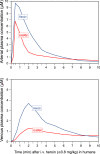Heroin and its metabolites: relevance to heroin use disorder
- PMID: 37031205
- PMCID: PMC10082801
- DOI: 10.1038/s41398-023-02406-5
Heroin and its metabolites: relevance to heroin use disorder
Abstract
Heroin is an opioid agonist commonly abused for its rewarding effects. Since its synthesis at the end of the nineteenth century, its popularity as a recreational drug has ebbed and flowed. In the last three decades, heroin use has increased again, and yet the pharmacology of heroin is still poorly understood. After entering the body, heroin is rapidly deacetylated to 6-monoacetylmorphine (6-MAM), which is then deacetylated to morphine. Thus, drug addiction literature has long settled on the notion that heroin is little more than a pro-drug. In contrast to these former views, we will argue for a more complex interplay among heroin and its active metabolites: 6-MAM, morphine, and morphine-6-glucuronide (M6G). In particular, we propose that the complex temporal pattern of heroin effects results from the sequential, only partially overlapping, actions not only of 6-MAM, morphine, and M6G, but also of heroin per se, which, therefore, should not be seen as a mere brain-delivery system for its active metabolites. We will first review the literature concerning the pharmacokinetics and pharmacodynamics of heroin and its metabolites, then examine their neural and behavioral effects, and finally discuss the possible implications of these data for a better understanding of opioid reward and heroin addiction. By so doing we hope to highlight research topics to be investigated by future clinical and pre-clinical studies.
© 2023. The Author(s).
Conflict of interest statement
The authors declare no competing interests.
Figures





References
-
- Merlin MD. On the trail of the ancient opium poppy: natural and early cultural history of papaver somniferum. Assoc Univ Press East Brunswick, New Jersey. 1984.
-
- Dikötter F, Laamann LP, Xun Z. (eds) Narcotic culture: a history of drugs in China (Hong Kong University Press, 2004).
-
- Courtright DT. (eds) Dark paradise: a history of opiate use in America (Harvard University Press, Cambridge, 1982).
Publication types
MeSH terms
Substances
LinkOut - more resources
Full Text Sources
Medical

